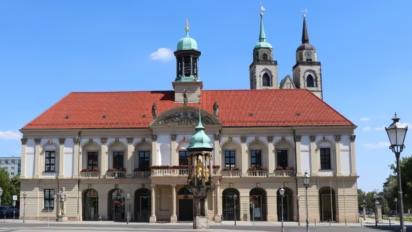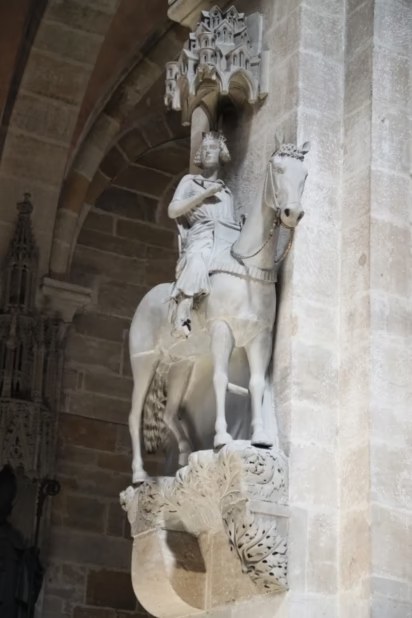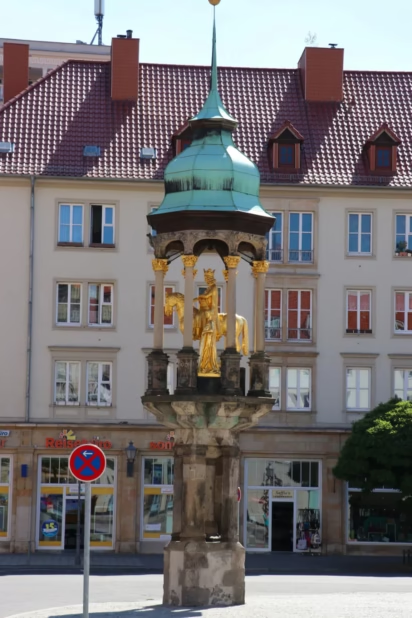The mid-13th-century Magdeburger Reiter (Horseman of Magdeburg) in Germany was the first freestanding full-size equestrian statue made since classical antiquity and north of the Alps.
The Magdeburger Reiter, originally installed on the market square in Magdeburg but now inside the local museum, depicts a horseman accompanied by two female figures. It was the first large freestanding equestrian sculpture produced since classical antiquity and probably also the first-ever produced in Germany. It is almost certainly a portrayal of Otto I the Great, the first German emperor of the Holy Roman Empire, who had strong links with Magdeburg. This rare secular medieval stone sculpture was produced by the workshop of the cathedral but never had any religious significance. A gilded bronze copy is on permanent display on the Alte Markt in Magdeburg while the original may be seen inside the local history museum (Kunsthistorisches Museum).
Magdeburger Reiter Equestrian Statue

The Magdeburger Reiter (Magdeburg Rider, also Horseman of Magdeburg) was produced around 1240 in Magdeburg, was the first freestanding equestrian statue produced in Europe since classical antiquity. It was also the first life-size equestrian statue produced north of the Alps. (The same is claimed for the Bamberger Reiter from the same period — more below.)
The Magdeburg Rider is a composition of three sandstone statues: a larger equestrian statue accompanied by two female figures. The rider is a young man wearing a crown — almost certainly a depiction of Otto the Great. He is flanked by two females, usually described as maidens (Jungfrauen) and representatives of the people. It is highly unlikely that they are supposed to depict the rider’s wife, daughters, or other family members.
One of the maidens carries a shield that still bears the markings of a painted imperial eagle while the second carried a lance (probably a flagstaff / Fahnenlanze), now lost. Both the eagle and flagstaff hint at imperial links and support the notion that the rider is Emperor Otto I — no other emperor or regal figure had stronger links to Magdeburg in the four centuries preceding the creation of the work.
The equestrian sculpture including horse and rider measures 240 cm tall, (335 cm including the pedestal), around 90 cm wide, and 187 deep. The female figures are around 1.45 m tall.
Although the Magdeburger Reiter has always been a secular work, it is attributed to the “Reitermeister” an unknown artist working in the masonry workshop of the cathedral. He is also credited with producing several sculptures in the Dom including a famous sculpture of St Maurice — the first depiction of a Black African in central European art.
Otto the Great as Magdeburg Rider
In 936, Otto I became duke of Saxony and king of Germany at the relatively young age of 24 (although his grandson Otto III managed this aged three!). He was crowned Holy Roman Emperor in Rome in 962, by which time he already had a formidable reputation. He died in 973 and was buried in Magdeburg Cathedral, where his sarcophagus is still in the center of the choir of the first Gothic cathedral erected in Germany.
His long reign was astonishingly successful and he is generally referred to as Otto the Great (Otto 1. Der Großen). He is seen as the first German Holy Roman Emperor. He founded the Ottonian dynasty and a period of learning and renewal often referred to as the Ottonian Renaissance. As an architectural style, it was influenced by Carolingian and Byzantine architecture — the finest surviving example is the Michaelskirche in Hildesheim.
The Magdeburger Reiter is almost certainly a depiction of a young Emperor Otto I (the Great), who had very strong links with Magdeburg. Although Magdeburg existed since the times of Charlemagne, as a small outpost on the border with the Slavic tribes across the Elbe River, Otto is generally seen as the true founder of the city.
Otto founded the Benedictine monastery of St Maurice in Magdeburg in 937 and subsequently tried to turn the city into the third Rome (Constantinople was second). He erected the largest imperial palace in Germany here and a large Romanesque basilica (which was being replaced by the first Gothic cathedral in Germany around the time the Reiter was made).
Meaning of the Magdeburger Reiter
As with the identity of the rider, the true meaning of the Magdeburger Reiter can also only be speculated about. It is sometimes thought that as a sculpture of Emperor Otto I, it depicts the rights and freedom of the citizens of Magdeburg. Although Magdeburg never succeeded in becoming a free imperial city, the citizens enjoyed many freedoms despite frequent clashes with the local governing archbishops.
The rider faces the Rathaus (town hall) and another medieval symbol of a city’s freedom — a large statue of Roland, usually seen in cities that belonged to the Hanseatic League. The current Roland is a 2005 copy of the original destroyed in 1631.
Equestrian statues were important symbols of power during antiquity and Charlemagne also had a large equestrian statue brought from Italy to Aachen during his reign. Whether Otto I similarly had an equestrian statue brought up from Italy to his palace in Magdeburg is unknown, although he did import some pillars used in antiquity in Ravenna for use in the Romanesque basilica (several were repurposed in the later Gothic cathedral).
Although the Magdeburger Reiter was made three centuries after the Ottonian period, it reminded of the glory of Magdeburg and the imperial reign. It was also made at the same time as the construction of the Gothic cathedral that kept Otto’s sarcophagus in the center of the choir of the new church.
Bamberger Reiter vs Magdeburger Reiter
The Bamberger Reiter is a fairly similar equestrian statue and was produced around the same time as the Magdeburger Reiter. The same claims as the first equestrian statue since antiquity and north of the Alps are thus also made for this work. It is impossible to really say now which one came first.
The Magdeburger Reiter was always a freestanding sculpture, while the Bamberger Reiter and a few similar sculptures in Italy are all mounted against a wall. The Magdeburg Rider was always a completely secular work, while the Bamberg Rider is inside a church, although its rider is unlikely to be a Biblical figure (though it possibly could be). Also, while there is little doubt that the Magdeburger Reiter is Otto I, little agreement exists on the identity of the Bamberger Rider.
It may be good form to simply give credit depending on where one is. In fairness, Bamberg, which was also proclaimed the new Rome at times, has many more sights to visit than Magdeburg. However, both sculptures are extraordinary works for the period and worth the claims to fame.
Presentation of the Magdeburg Rider
The Magdeburg Rider group consists of around a hundred individual stone pieces. Specialists could easily identify the original pieces, as they were made from stone quarried in Bernstein on the Elbe River, while later repairs were made from sandstone from the Elbsandsteingebirge (south of Dresden).
The presentation of the group on the market square in Magdeburg changed slightly through the centuries. It was originally mounted under a Gothic baldachin with the sculpture painted in at least blue, green, red, and white.
The Rider survived the Thirty Years’ War in which Magdeburg was completely destroyed — generally considered the worst destruction of a German city in war until the horrors of the Second World War. (Magdeburg’s population fell from 35,000 in early 1631 to only 1500 in 1639. At least 20,000 were killed during the siege and destruction of the city in 1631 by Imperial troops led by Tilly.)
By the mid-17th century, the presentation became more baroque — this basic canopy and pedestal survived although accompanying statues and decorations were added (and often lost again) through the centuries. The main statues were gilded in this period — probably to give the impression that the city had recovered its former wealth and importance
During the Second World War, during which much of the center of Magdeburg was destroyed in air raids, the statue survived in safekeeping. It returned to the market square after the war.
The biggest change in its presentation came in the 1960s. The original stone sculpture was moved for conservation reasons to the Kunsthistorisches Museum (local history and art museum). A bronze copy made by Heinrich Apel complete with flagstaff but without imperial eagle was installed in its place on the market square in 1966. The sculptures on the market square were gilded in 2000 — quite striking when the sun shines.
The original stone sculpture may be seen in the Kunsthistorisches Museum (local history and art museum) where it is by far the top attraction.





